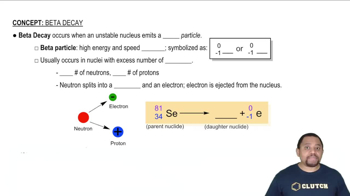Here are the essential concepts you must grasp in order to answer the question correctly.
First-Order Kinetics
First-order kinetics refers to a reaction rate that is directly proportional to the concentration of one reactant. In the context of radioactive decay, this means that the rate at which a radioactive substance decays is dependent on the number of undecayed nuclei present. The mathematical representation, rate = -∆N/∆t = kN, indicates that as the number of nuclei decreases, the rate of decay also decreases.
Recommended video:
Half-Life
The half-life of a radioactive substance is the time required for half of the radioactive nuclei in a sample to decay. This concept is crucial for understanding the decay process, as it provides a consistent measure of how quickly a substance will lose its radioactivity. For strontium-90, with a half-life of 29 years, after each half-life, the remaining quantity of the substance is halved.
Recommended video:
Exponential Decay
Exponential decay describes the process by which a quantity decreases at a rate proportional to its current value. In radioactive decay, this means that after each half-life, the amount of the substance remaining can be calculated using the formula N(t) = N0 * (1/2)^(t/T), where N0 is the initial quantity, t is the elapsed time, and T is the half-life. This concept helps in determining the fraction of strontium-90 remaining after multiple half-lives.
Recommended video:
 Verified step by step guidance
Verified step by step guidance


